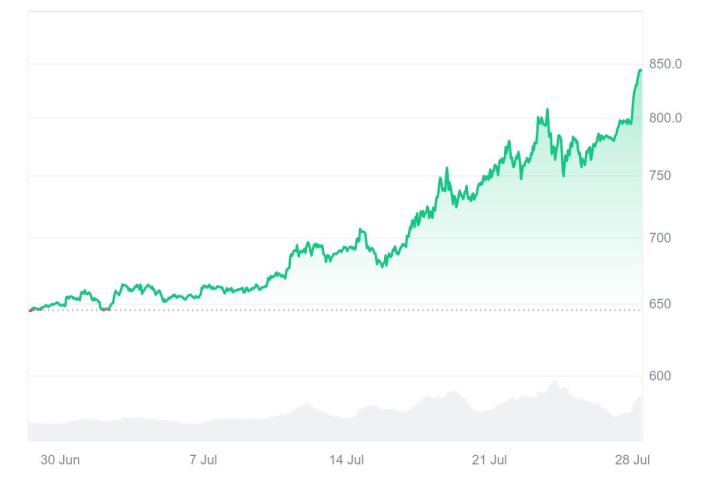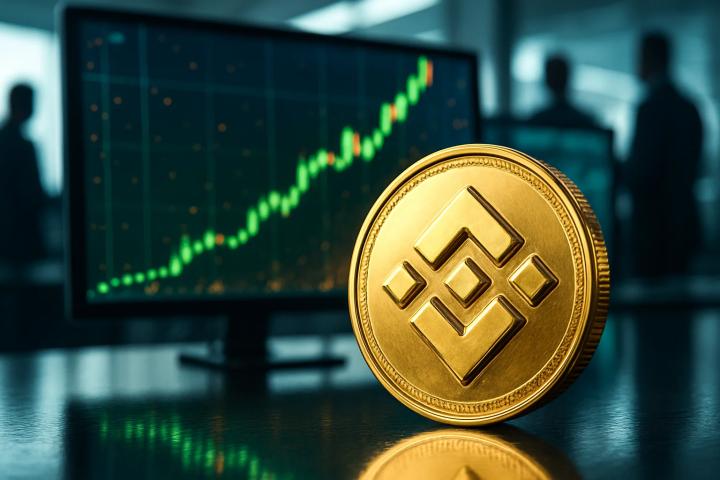Deng Tong, Jinse Finance
On July 28, 2025, BNB broke through $850, closing at $850.37, with a daily increase of 6.8%. Since BNB broke through $700 on July 11, its price has soared, and just 12 days later, BNB broke through $800. The recent surge has pushed BNB's market value to over $115 billion, becoming the fourth-largest cryptocurrency by market capitalization.

What is driving BNB's continuous rise? How high can it go? Is a crypto treasury reserve bubble forming?
I. What is causing BNB's continuous rise?
1. Binance Finance Announces RWUSD Launch
On July 28, 2025, according to the official announcement, Binance Finance announced the launch of RWUSD, a principal-protected financial product offering users returns on tokenized real-world assets (RWA) such as US Treasury-grade bonds. Users can earn up to 4.2% annual yield by purchasing RWUSD. Users can use designated stablecoins (USDT or USDC depending on regional availability) to purchase RWUSD. After purchase, users will receive an equal amount of RWUSD in their spot account at a 1:1 ratio, with no purchase fees. Upon redemption, RWUSD will be converted to USDC at a 1:1 ratio, regardless of the initial stablecoin used. Users can choose quick or standard redemption, with corresponding fees applied.
However, it's worth noting that BNB had already shown a remarkable upward trend before this announcement. Such a significant rise before positive news inevitably raises suspicions of potential information leaks and early market moves by some investors.
2. Multiple Companies Adopting BNB as Treasury Reserve
CZ previously responded on social platforms about BNB's potential treasury inclusion: Over 30 teams want to launch companies related to BNB treasury.
In the current cryptocurrency treasury reserve wave, mainstream cryptocurrencies like BTC, ETH, and BNB are being included in treasury reserve assets. Recently, multiple enterprises have announced BNB as their corporate treasury reserve asset. This directly boosted market confidence in BNB's long-term prospects and rapidly lifted its price.
[The rest of the translation follows the same professional and accurate approach]Bitcoin mining difficulty index decreased by 18% year-on-year in Q2 2025, while hash rate growth was only 5%, reflecting weakened network security; Ethereum DeFi protocol Total Value Locked (TVL) reached $127 billion, but actual user growth was only 3%, with most trading volume coming from market maker arbitrage.
Be Water's July 2025 analysis discovered that today's Bitcoin Treasury companies and investment trusts from the 1920s "reveal a recurring speculative pathology" - a "blueprint for reflexive bubbles"that transcends eras and asset classes.
In mid-1929, Goldman Trading Company was established, dubbed the "MicroStrategy of its time", where investors paid "two or three times" the value of underlying assets. Yale economist Irving Fisher asserted before the 1929 stock market crash that the market would remain at a "permanent high plateau". Today, Bitcoin bulls loudly proclaim even higher targets, similar to the situation then.
Fisher's statement was to defend 1920s trusts as market support. This is similar to Saylor's current advocacy of Bitcoin Treasury as a superior investment tool. In the 1920s, US trusts proliferated selling speculative bonds with warrants, similar to Saylor's convertible bond and stock option sales. This created an "endless supply of speculative securities" to satisfy insatiable demand.
2. Stock Crash Risk
According to a July 2025 survey, over half of this year's BTC Treasury company stocks have traded at least 50% below their year-to-date highs. (Median decline from peak was approximately -52%)
Wall Street analysts warn that stocks rising 10 or 20 times could also crash rapidly. There's a high likelihood that traders would watch Bitcoin Treasury company stocks "plummet" in panic, with no institutional buyers or bankers to support them.
Extreme premiums bring enormous risks: if Bitcoin price or investor sentiment reverses, these stocks' collapse could be more severe than Bitcoin itself.
3. Investors Betting on Future
Investors are paying for promises of future Bitcoin appreciation, which can only continue while market sentiment remains hot. If crypto market sentiment changes and cryptocurrency prices can no longer convince investors to enter the market, there might be a risk of market collapse.
When even small companies can see stock price surges by hoarding cryptocurrencies, it means market sentiment is already overheated. Investors are universally optimistic about these companies' future prospects, ignoring that their stock values lack substantive industrial support, with popular hype concealing underlying risks.
The crypto market bubble formed by the crypto Treasury enterprise trend is taking shape. Before the bubble bursts, the market will continue its revelry, but only when the music stops will we see whether this new trend is a genuine financial revolution or just a fleeting capital game.








